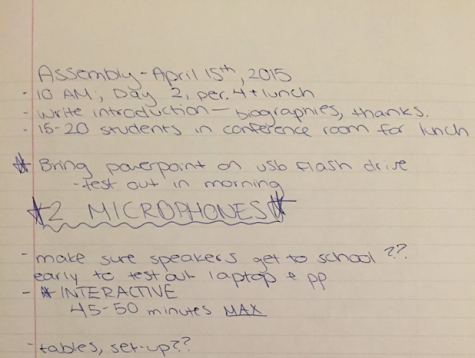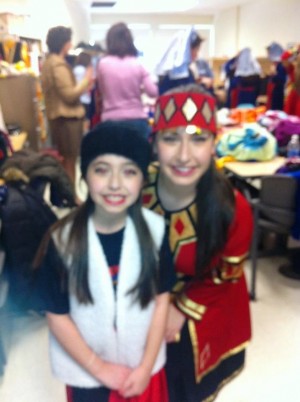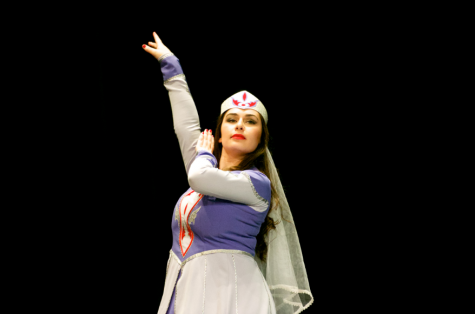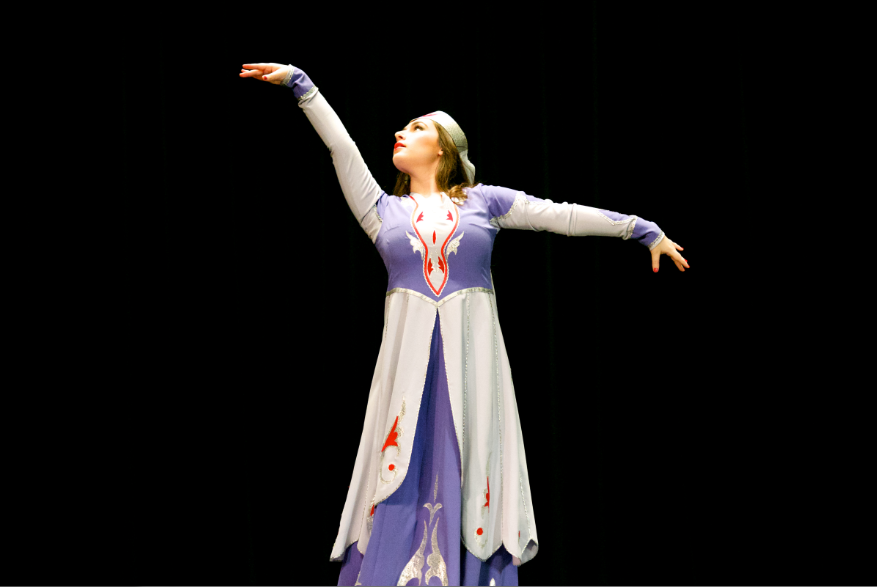The one girl show: The student-run assembly you should know about
For one junior, the Armenian Genocide is personal
April 14, 2015
As high school students, the point of learning about history is so that the past doesn’t repeat itself. But can these atrocities be prevented if students are never taught that the tragedy exists in the first place?
This is the question that Victoria Messikian, junior, has wrestled with her entire life.
This upcoming April 24 marks the 100th anniversary of the Armenian Genocide. Although this significant event is not recognized nor taught in New Jersey schools, Messikian plans to share her culture with her school through a commemoration assembly.
Messikian specifically waited until this year to share her idea to create this assembly, although it has remained with Messikian since she first conceived of the idea in the sixth grade. Back then, Messikian decided that if the Armenian Genocide had not become recognized by the American and Turkish Government by the one hundredth anniversary of the event she would proceed with planning the assembly.
The Armenian Genocide has still not been recognized, and Messikian moved forward with her plans.
Although there is a minimal Armenian population at Glen Rock High School, Messikian is eager to share the history of her people with the school. The assembly is currently open to juniors and all other interested students. After the assembly, a small group of invited students will participate in a luncheon to ask questions and learn more about the assembly.

Victoria Messikian’s notes in the pre planning stages of the Armenian Genocide Assembly.
PLANNING THE ASSEMBLY
In order to plan this assembly, Messikian has collaborated with the high school History department and Armen Sahakyan, a Board Member of the Armenian National Committee of America Eastern Region. Sahakyan has been advocating for the recognition of the Armenian Genocide in Iowa since his high school career, and he has worked for the ANCA for around eight years.
The Armenian National Committee of America “is the largest and most influential Armenian American grassroots political advocacy organization,” according to Sahakyan.
The ANCA supports the following: fostering public awareness in support of a free, united and independent Armenia as well as influencing and guiding U.S policy on matters of interest to the Armenian American community.
Sahakyan will be joined by Molly Sullivan, Director and Curator of the Near East Relief Historical Society (an educational initiative of the Near East Foundation), who will also be coming to Glen Rock High School to inform students about the tragedies of the Armenian Genocide. Sullivan holds holds a master’s degree in Museum Professions from Seton Hall University and a law degree from Brooklyn Law School. She has been employed in many fields; prior to working for NEF, Sullivan worked as an insurance defense attorney with a small Long Island firm. She has also worked at the Museum of Jewish Heritage — A Living Memorial to the Holocaust, the Mount Vernon Hotel Museum and Garden, and the Albright-Knox Art Gallery.Together, Messikian, Sahakyan, and Sullivan will share the history of the Armenian Genocide.
“We want to highlight the key role that the American people played in saving Armenians, stretching over three American presidential administrations and being deeply ingrained in the American history,” Sahakyan said.
Planning for the assembly started in September 2014 and will continue to the day of the assembly, April 15. Messikian, Sahakyan, and Glen Rock faculty members considered many factors in order to produce an effective assembly.
Christopher Pohlman and Justin Ecochard, two Glen Rock High School History teachers, assisted Messikian in planning the logistics for the assembly.
“Who is going to see the assembly, which classes are going to see the assembly, who would benefit most from seeing the assembly, do we have an available room in the school building to do the assembly? Time constraints. How long should the assembly be?” Pohlman said as he listed concerns the faculty members confronted.
For the high school staff, the most difficult part has been scheduling.
“That’s been the biggest logistics, as has securing someone to come in and even speak because people have their own outside schedules as well, and trying to coordinate everything can be a little bit of a challenge.”
For Pohlman, the intricate process of planning a student-run assembly is something that he has never faced before.
“This is the first time that one of the students ever wanted to almost produce an assembly on her own as a remembrance,” Pohlman said.
On the other hand, Sahakyan’s emphasized the efforts that are “placed on the American humanitarian response to save tens of thousands of Armenian Genocide survivors, most of whom were orphaned children.”
For Messikian, this is a piece of her personal history: her great grandmother was one of those affected orphans.
“My great grandmother became an orphan during the genocide and was put in an orphanage. There was an organization at the time that rescued orphaned Armenian girls and married them off to Armenian men in the US when they became of age,” Messikian said.
HISTORY OF THE ARMENIAN GENOCIDE
“It’s an assembly about genocide. And genocide is something that can affect any group,” Pohlman said. “The idea of genocide has been with us since time began, in essence, and it will still be with us as we move forward.”
The Armenian Genocide occurred in 1915, when the Ottoman Turks started the execution, murder, and genocide of the Armenian people. The Armenians who were not killed outright were transported, removed, and exiled from their homelands, forced to move to other places. The Ottoman Turkish government systematically removed the Armenian people from their homeland, which is modern day Republic of Turkey.
Severe punishments include arrests, assaults, massacre, food and water deprivation, and death marches to the Syrian desert.
“I can imagine that they were probably very frightened and thought that it would, for sure, be the end of Armenians as a whole. But they were very strong and persevered and, because of their strength and faith, Armenians still live on today,” Messikian said.
Although many Armenians were executed during this time in history, only twenty two countries recognize this atrocity as genocide. Both the United States government and the Turkish government have yet to recognize this disastrous event; it is this lack of recognition that motivates Messikian to share the brutality that her people faced.
The Armenian Genocide is not a topic that is taught in American schools. Pohlman explained that he was not taught about the Armenian Genocide while in high school, and he feels that this assembly will be an informative opportunity for him to learn more about the subject.
“It’s not deliberately ignored, but when you’re talking about the question of genocide in general, whether it be the Armenian genocide or not, it’s not a topic that should just be plopped in a curriculum some place,” Pohlman said.
Pohlman added that high schools throughout the nation should consider adding classes to the Social Studies curriculum that would focus on specific topics, like the Armenian Genocide, to offer an educational opportunity to study these events.
“An assembly like this can do nothing but educate the public about the topic itself and about a horrible thing that happened one century ago that doesn’t have that much space in the history books,” Pohlman said.

Victoria and Alyssa Messikian getting ready for a traditional Armenian dance performance.
MESSIKIAN’S FAMILY HISTORY
Armenia was the first country in the world to adopt Christianity as its official religion in 301 A.D. Yet between the 16th and 19th centuries, Armenia was ruled by the Ottomans and Persians, leading up to the genocide on April 24, 1915.
“That’s when 1.5 million Armenians were killed and that’s when many more Armenians were deported,” Ani Messikian, Victoria’s mother, said.
Because of this displacement of Armenians, Ani Messikian’s parents’ families settled in Syria. Although Ani is also Armenian, she has never been to Armenia. She came to America at the age of eight.
Although she faced adjustments in American schools, culture remained an important part of her life.
“I think we are strong with our community, our schools, our church…everything,” Ani said.
Ani, who is now a real estate agent, shares her cherished cultural heritage with Victoria and her two other daughters, Alyssa and Sophia. Armenian language, food, and music are all cultural aspects that the Messikian family hold dear.
“Even though I don’t cook special Armenian food at home, they do it with their grandparents, their grandmothers on both sides. So we definitely make an effort to keep the culture alive,” Ani said.
The Messikians are a devoutly religious family, celebrating the Epiphany, or Armenian Christmas, on January 6 every year. They also annually attend the Armenian Genocide commemoration located in Times Square.
“It’s nice to have this type of commemoration in the heart of New York City because it captures the attention of the people in New York City and around the world which makes the Armenian Genocide more known,” Victoria said.
The commemoration in Times Square will be held on April 26, beginning at 1:45pm between Broadway and 43rd street.
SHARING HER CULTURE THROUGH POETRY
When Victoria began piano lessons at the age of six, her piano instructor gave her an unexpected assignment.
“She told me that I should memorize this little paragraph of poetry and the next week when we would meet we would just see how I did. It was just for fun and I don’t think she was expecting very much out of it,” Victoria said.
From then on, though, Victoria received more and more Armenian language poems from her piano teacher. Victoria began reciting poems at fundraisers and other Armenian events.
“She was articulate, she recited them well, and it just kind of spiraled from there,” Ani said. Victoria recited poems in Armenian at different events, such as Armenian fundraisers and other cultural events.
“Most of the poems were about the Armenian Genocide — very heartfelt poems. Some of them were about Armenian patriotism and just the general love for the country,” Victoria said.
After reciting poems at a number of events, Victoria was asked to share a “very well known” poem at the Armenian Genocide commemoration in Times Square. Victoria recited the Armenian poem, “Menk Keetch Enk” by Paruyr Sevak, at the Times Square commemoration in 2007.
After the recitation of the poem, Victoria was asked to speak on a radio broadcast. Victoria was featured on the Armenian Radio Hour of New Jersey to speak about her recitation in Times Square.

Victoria Messikian performing a traditional Armenian dance at the 2014 Christopher Barron Fundraiser.
ON THE STAGE
Victoria Messikian is also an Armenian dancer. She became involved with Armenian dance after hearing about it through the Armenian community.
Having started at the age of six, Messikian continues to learn Armenian dance, which has allowed her to make Armenian friends.
Armenian dance is “graceful, slow, and like artwork on the stage,” according to Messikian. The types of dance range from slow to faster dances that are more upbeat. The dancers move in unison, taking spin after spin as their costumes flow around their bodies.
Messikian dedicates her Friday evenings to dance rehearsals. Her dance group, the Shushi Armenian Dance Ensemble, will embark on a trip to Moscow and Armenia in the summer of 2015.
Independently, Messikian performed an Armenian dance at the Christopher Barron Fundraiser in 2014.
Her mother thought it was a natural form of expression.
“She loves to dance so it was a nice fit,” Ani Messikian said.
Messikian has also shared her culture by exposing her friends to many different Armenian traditions. Ari Berke, junior, is one of Messikian’s friends who has had the opportunity to try Armenian food.
“I feel like spreading my culture to my friends is a good way to make them more familiar with Armenia,” Messikian said. “Before people in Glen Rock met me they had no idea that the country of Armenia even existed so I think that I’ve made a pretty big impact on Glen Rock because I’ve educated a lot of people on it.”
Messikian has been invited to participate in a play about the Armenian Genocide in June that she is extremely excited about. Although Messikian has not participated in any plays about the Armenian genocide in the past, she is eager to share her culture through another form of arts.
“I play a seventeen year old Armenian girl living in Turkey who goes to a school with all Turkish students. She is tormented and abused in the school because of her Armenian heritage, but she continues to wear her Armenian cross around her neck and endures the cruel words and actions,” Victoria said.
“It’s really a powerful play and I became emotional reading the script for the first time because I immediately placed myself in the character’s shoes.”
The play will be performed in Armenian, and Messikian is currently working on memorizing the lines for her part in the play.
FINAL DETAILS
As the event quickly approaches, Messikian, Sahakyan and the Glen Rock High School faculty finalize the last details for the assembly.
Molly Smith, senior, has volunteered to bake three hundred cookies individually wrapped for every person that attends the assembly. The cookies will be divided by color: red, orange, and blue, the colors of the Armenian flag.
“They say #1915 wrapped in little baggies, and they’re going to be on display like the flag,” Messikian said.
Messikian is not the only one that choose to express her culture in time for the anniversary of the genocide. Celebrities Kim and Khloe Kardashian have recently taken a trip to Armenia to embrace their Armenian heritage. Both Kardashians visited the Armenian Genocide assembly in their homeland, and broadcasted their commemorations via social media.
“I’m so happy that the Kardashians decided to take this trip to Armenia. Being that the centennial anniversary is only in a few weeks, I think they chose the perfect time to go there because their millions and millions of followers are now aware that the Armenian Genocide occurred,” Messikian said.
“Their constant postings of their trip on Instagram, Facebook, and Twitter have called so much attention to the genocide and it has now been reported on all over the world, in the most well-known news stations of all time. Their trip has brought more attention to the Armenian Genocide in only eight days which is more than the Armenian people have achieved in one hundred years.”
As the anniversary approaches, more attention has been drawn to the recognition of the event. On April 12, 2015, Pope Francis recognized the genocide while speaking at a mass in St. Peter’s Basilica to mark the 100 years since the killings occurred. According to the Wall Street Journal, Pope Francis recognized the event as the first genocide of the twentieth century.
As the assembly approaches, Messikian looks forward to informing the Glen Rock High School student body and faculty of the Armenian Genocide: an event that many people were unaware of.

Liza Ogulluk • Apr 15, 2015 at 8:06 am
You and your family should be very proud
Maral Mirzoian • Apr 14, 2015 at 8:42 pm
Bravo Victoria we are so proud of you everything you said so touching and true Abris hokis all our grandparents they will be so happy what your doing for them we need more of you your parents and us we are so happy having you you have great seeds Abris love you hamovig great job